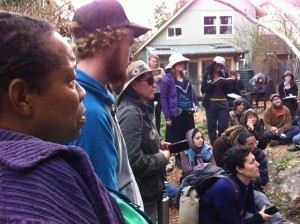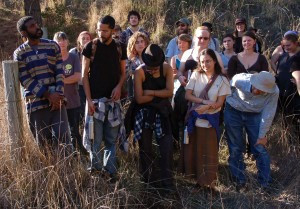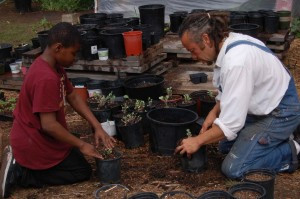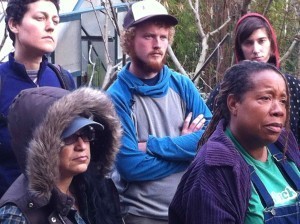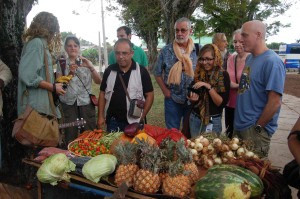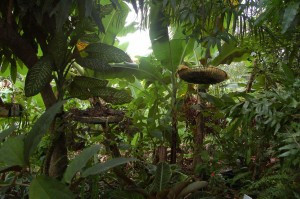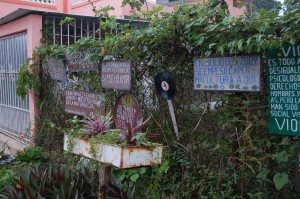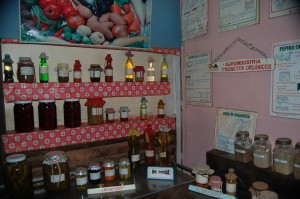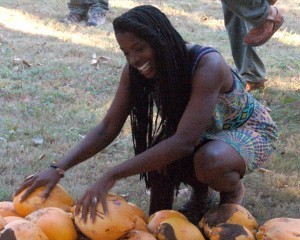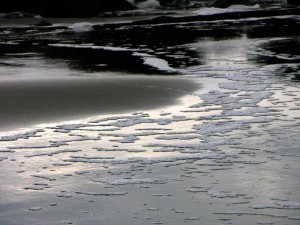Starhawk's Blog
November 19, 2025
Stargazing Made Simple: Beginner’s Guide for 2026 Night Watchers
Ever looked up at the night sky and thought, “I wish I knew what I was looking at”?
Trust us, you’re not alone on this. Most people who want to try stargazing never start because it seems too complicated. With telescopes, star charts, constellations with weird names, where do you even begin without making a fool of yourself?
Fortunately for you, stargazing in 2026 is surprisingly easy now. And this guide covers everything beginners actually need to know about stargazing. You’ll find out:
What you’ll see in 2026 Which free tools help the most How to prepare for your first night under the starsSo, let’s read it all to prepare, and then explore the universe!
Stargazing 2026 Brings Incredible SightsYou’d be overjoyed to know that 2026 is actually one of the best years for stargazing in over a decade! The year is full of major celestial events visible across the northern hemisphere and the southern hemisphere
We’re talking about a total solar eclipse, meteor showers during perfect moon conditions, and planets at their brightest positions. So if you’ve been waiting for the right time to start watching the night sky, this is your star sign!
Let’s look at the highlights that you wouldn’t want to miss.
Total Solar Eclipse on August 12On August 12, daylight will fade to darkness, and the moon will completely cover the sun for a few unforgettable minutes. This eclipse path runs through Iceland, Greenland, and northern Spain. Here’s the key information in short:
Date: August 12, 2026Visible From: Iceland, Greenland, parts of SpainNext chance: 22 July 2028 from AustraliaYou’ll need eclipse glasses to watch this event safely. Remember to never look directly at the sun without proper eye protection. But during totality, when the moon completely covers the sun, you can remove your glasses briefly and see the corona.
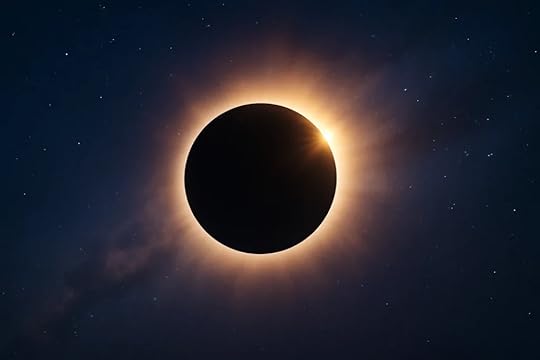
Pro tip: Book early if you plan to travel because hotels in Iceland are already filling up. Flights and tour packages for eclipse viewing always sell out months in advance. So plan your trip as early as possible.
The Perseids Meteor Shower in AugustThis year’s Perseids will be spectacular thanks to a new moon. That means there’ll be no glare and the skies will be extra dark. You can expect up to 60 shooting stars an hour, that’s roughly one every minute. Take a look at the timetable:
Peak dates: August 12-13Best time: 2 AM – 4 AMWhere to watch: Any dark spot away from city lightsPro tip: Find any dark spot away from city lights and prepare a blanket. It’s best to lie back and give your eyes at least 20 minutes to adjust. And then enjoy the show from a front-row seat to some of the sky’s most dazzling moments.
Stargazing in the Night Sky Without GearLet us tell you something that most beginners get wrong: they think stargazing requires a telescope.
Your eyes are already powerful enough to see thousands of stars, several planets, and even parts of our galaxy. So you won’t need any gear, any fancy setup, or any learning curve. You can literally step outside tonight and start watching the stars.
Let us tell you about what’s up there.
Constellations You Can Find EasilyThe patterns of some constellations have guided travellers, storytellers, and dreamers for centuries. So you don’t need a chart or an app to get started, just a clear sky and a bit of curiosity.
To spot them in the sky, you can look for these:
Big Dipper: The Big Dipper is your starting point. It stays visible year-round in the northern hemisphere and appears as seven bright stars shaped like a pot with a handle. The two stars at the front of the “pot” point directly to Polaris, the North Star. Orion: In winter, look for Orion. That’s the three bright stars that line up perfectly to form his belt, which you definitely can’t miss. Orion sits right on the celestial equator, so people in both hemispheres can see it.Milky Way: You’ll only spot the Milky Way from truly dark locations away from city lights. It stretches across the sky like a hazy, cloudy band. That’s our home galaxy, seen from inside looking out.These constellations are like landmarks in the sky. Once you recognise a few, the night will start to feel like you’ve unlocked a secret map above you.
 Planets That Look Like Bright Stars
Planets That Look Like Bright StarsUnlike stars, planets don’t twinkle as brightly. But once you know about them, they’re surprisingly easy to find, even from a city balcony.
Try spotting these bright wanderers next time you’re outside:
Venus: Venus is the brightest “star” in the evening or morning sky. It’s so bright that people sometimes mistake it for an airplane or a UFO.Jupiter: Jupiter comes in second in terms of brightness. It has a steady, golden light that doesn’t twinkle like stars do.Saturn: Saturn has a soft glow near the horizon after sunset. It won’t twinkle like nearby stars do. That steady light gives it away every time.Mars: Mars has a distinctive reddish tint. Even from cities with lots of light pollution, you can pick it out.Mercury: Mercury is a bit harder to find because it stays close to the sun. You can look for it low on the horizon just after sunset or right before sunrise. But be quick because you’ve only got a small window to catch it.So now that you know these, step outside, look up, and see how much of the universe you can find with your own eyes.
Best Apps for Stargazing 2026Remember when people used to carry thick star charts and struggle to read them with dim red flashlights? Well, those days are over.
Now your phone has a lot of free apps that can identify every star, planet, and constellation above you in seconds. And most of these apps work offline, so you don’t need cell service at remote dark sites.
We’re here with the two types of apps you actually need.
Stellarium for Real-Time Sky MapsStellarium is like having a planetarium in your pocket. You just have to hold up your phone, and it instantly matches the stars above you. You can see constellations, planets, and even satellites move in real time as you tilt or turn your screen.
And the offline mode is handy when you download the star database before heading out. You’ll still get millions of stars and celestial objects even without the internet. Plus, the free version displays stars, planets, and even details about the altitude and brightness of celestial objects.
ISS Tracking Apps for Satellite SpottingThe ISS Detector tells you exactly when the International Space Station will pass overhead. You’ll get a notification about 30 minutes before it appears, and the app guides you on where to
Now, when it shows up, it will look like a bright, fast-moving star gliding silently across the sky. The best times to watch satellites are just before sunrise or right after sunset when sunlight can catch the station’s surface.
 Find Your Perfect Dark Sky Spot
Find Your Perfect Dark Sky SpotLight pollution is the greatest enemy of stargazing. Why? It’s because city lights wash out faint stars, blur the Milky Way, and make meteor showers harder to see.
But the good news is you don’t have to drive hours into the wilderness to find decent skies. Since most people actually live within 30-60 minutes of a spot dark enough for solid stargazing, you just need to know where to look.
And that’s where light pollution maps come in.
What is the Light Pollution Map?Light Pollution Map is a free website that shows you exactly how dark (or bright) the skies are near you. There’s also Dark Site Finder with similar functions. They use colour codes to indicate different levels of pollution. For example,
Dark Blue/Black: Amazing stargazingYellow/Orange/White: Too much lightThese maps use something called the Bortle scale. It rates sky brightness from 1 (pitch black, pristine) to 9 (city centre, terrible). So you have to aim for Bortle 4 or lower for good views.
Many certified Dark Sky parks achieve Bortle 1-3 zones. So these locations often have the blackest skies for seeing deep space objects like galaxies and nebulae. Along with these, state parks work too, and they’re often closer to home than you’d think.
See the Solar System up Close With BinocularsIt may sound unexpected, but binoculars usually work better than a telescope when you’re starting out.
Sure, telescopes sound exciting, but they’re pricey, bulky, and take patience to master. You’ll need to align them, track moving objects, and deal with lots of advanced adjustments. So it’s a bit much when you’re still getting used to the night sky.
But for binoculars? You can just pick them up and start your stargazing right away. These are some of the things you can see with binoculars:
You can see Jupiter’s four biggest moonsYou can even spot Saturn’s rings as tiny “ears.”The Moon’s craters look crisp enough and full of texture.Pro tip: When you’re buying a binocular, a solid beginner pair is 10×50 binoculars (10x magnification, 50mm lenses for brightness). They’re light, affordable ($50–150), and you can also throw them in a backpack, use them for hiking during the day.
Stargazing 2026: The Year You Finally Look UpYou don’t need perfect skies or fancy gear to begin stargazing. Just step outside tonight, find a few constellations, and maybe open an app like Stellarium. And you’ll be surprised how much more you can see when the city lights fade away.
All you need to do is start. The Perseids and August 2026’s solar eclipse will happen whether you’re ready or not. And the planets are shining tonight, waiting for someone to notice.
So grab a blanket, step outside, and look up. The universe has been putting on this show forever, and it’s about time you caught it live.
The post Stargazing Made Simple: Beginner’s Guide for 2026 Night Watchers appeared first on Star Hawks Blog.
October 9, 2025
Backyard Stargazing Ideas for Families
Your kids probably spend too much time on devices. So do most families. But getting them outside doesn’t mean you have to plan another exhausting day out.
Believe it or not, the night sky above your backyard has all the free entertainment you need to hold their attention. Just grab some lawn chairs, wait for darkness, and let curiosity do the rest.
Backyard stargazing gives your family something to do together without the usual complaints. Even restless kids settle down once they start spotting stars and learning what’s actually out there.
The tips ahead cover simple ways to set up, activities that work for different ages, and how to keep everyone interested beyond the first ten minutes. Let’s jump into it!
Getting Started with Backyard StargazingMost parents dismiss the idea and think it takes a lot of time and effort to set up. But the truth is, you’re about five minutes away from your first stargazing session.
Here’s what you need to get started:
Find Your SpotWalk around your yard after sunset and see where the streetlights aren’t blasting directly overhead. That’s your spot. It’s usually the darkest corner that works best, even if it’s not the most convenient part of your backyard.
Now just toss down some lawn chairs or spread a blanket on the grass. Make sure it’s a cosy blanket, cause you’ll be looking up for a while, and neck cramps end the fun quickly.
Time It RightClear nights work better than cloudy ones (groundbreaking insight, I know). But it does help to check when the moon rises. A full moon washes out fainter stars, so aim for nights when it’s less bright or hasn’t come up yet.
From our experience, summer months tend to bring later sunsets, which means the kids can stay up without everyone freezing.
What You’ll NeedYou don’t need anything fancy. Your eyes work fine for spotting constellations and planets. Just grab a torch with red cellophane over it so you can see without ruining your night vision.
A star chart app also helps, but you can learn plenty without one. And binoculars beat a cheap telescope any day if you do want to upgrade later.
Activities Beyond Just Looking Up
Staring at the sky is great for about ten minutes. Then the kids start getting restless, and someone needs the toilet. We found that the trick is mixing in other outdoor activities that keep the whole evening interesting.
Constellation scavenger hunt: Print out a simple star map or use an app to create a list of constellations to find. The little ones love ticking things off as they explore the night sky. Also, the first person to spot Orion’s Belt wins bragging rights. You can even add shooting stars to the list if you’re feeling optimistic.Glow-in-the-dark games: Bring out glow sticks or those cheap light-up toys from the dollar shop. And because kids are more likely to sit still after they’ve had a chance to run around, play a quick round of frisbee or tag before settling down.Space-themed picnic: Pack some snacks and call it a “moon mission meal.” Gather everyone on blankets with food and decorations if you’re feeling fancy. We can’t explain it, but cheese and crackers taste better under the stars. And no one complains about eating outside when it feels like an event.Star stories and mythology: Tell (or make up) the old Greek myths about constellations. Because most of them involve drama, monsters, or both. And once kids’ curiosity kicks in, they realise there’s a proper story behind those dots.Night photography attempts: Hand older kids a phone or camera and let them try capturing the stars. Most shots won’t turn out, but they’ll have fun trying. Create a competition for the best image.While all of these sound fun, we’ll bet that the older kids will get bored faster than the younger ones. That’s is why we’ll cover some ideas for the teens in the sections below.
Ideas for Older KidsTeenagers and pre-teens need something that feels less like a family activity and more like their own project. Surprisingly, a nature journal works brilliantly for this.
Just hand them a notebook and let them sketch what they see in the night sky. They can draw constellations, track moon phases, or just doodle their thoughts about space. It’s their thing, not yours.
Older kids also love attempting star trails photography with a phone or camera. So, try setting up a tripod (or a stack of books), use a long exposure app, and see what happens. The pictures look impressive even when they’re slightly blurry.
You might notice that some of them are getting interested in identifying deep sky objects when you point them towards apps that show galaxies and nebulae. Once they start creating their own space logs and comparing notes from different nights, you’ve got them hooked.
Daytime Prep for Better Stargazing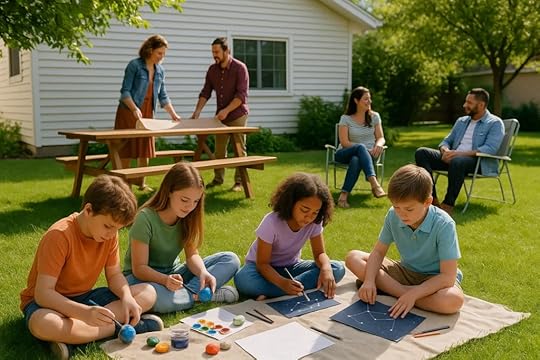
Most families overlook the daytime hours before the stargazing session. A bit of prep during the day goes a long way in making the activity more enjoyable for everyone.
Let’s look at a few activities you can plan:
Paint rocks like planets: Grab some rocks from the garden and let the kids paint them to look like Mars, Jupiter, or whatever they fancy. It gets them thinking about space before the sun even sets. Plus, you can use the painted rocks as decorations around your viewing spot later.Collect natural items for space crafts: Send the kids out to gather pine cones, leaves, and twigs. They can turn these into alien creatures or spaceships whilst you’re setting up dinner.Create constellation maps together: Print out blank star charts and have everyone colour them in. Older kids can add labels and facts they’ve looked up. And when night arrives, they’ll actually want to find the constellations they spent time drawing.Read space books in the garden: Spend twenty minutes outside with picture books about the moon and stars. Even just flipping through the pages gets younger children curious about what they’ll see later.These small activities turn stargazing from a random idea into something the whole family can prepare for together. A child’s curiosity grows when they’ve had time to think about space throughout the day.
Beyond Your Own BackyardWhile your backyard works brilliantly most nights, sometimes a change of scenery adds extra excitement. Like a local park with fewer streetlights often gives you a clearer view of the night sky. Try packing up your blankets and snacks, and make it a mini adventure without the hassle of driving far.

If you’re really keen, look up the nearest dark sky park for a special occasion. The difference is dramatic when you’re away from city lights. You might even spot things that never show up at home, and the Milky Way actually looks like the photos you see online.
During summer, you can mix stargazing with other outdoor activities. For instance, you can ride bikes to your viewing spot whilst there’s still daylight. Or fly kites in the afternoon, then stick around as the sun goes down. Beach trips can work too if you’re near the coast.
The time spent outside builds connection beyond just staring upward. And your kids will remember the whole evening, not just the stars.
Once you experience how nice it is, you might be tempted to make it into a regular thing.
Make Star Gazing a Regular TraditionThe first stargazing session is easy because it’s new. But keeping the excitement alive takes a bit more creativity. So, mix things up so it doesn’t feel like you’re doing the exact same activity every time.
Here are a few things you can try:
Try a water balloon fight before settling down to watch the sky.Plan an evening of fishing if you’ve got a pond nearby, then transition to stargazing as darkness falls.Pick flowers and pine cones during the day for craft projects you’ll work on the next afternoon.These little variations stop the routine from getting stale. And the moment your family starts asking when you’re doing it again, you’ve built something worthwhile.
Some nights you’ll catch a glimpse of the Milky Way. Other nights you’ll just lie there talking. Both count as time well spent, and that’s the whole point, really.
Ready to Start Tonight?You’ve got everything you need now. We covered finding the right spot in your backyard, timing your sessions for the clearest views, and keeping the kids entertained with activities beyond just staring upward.
The daytime prep ideas help build excitement before the sun even sets. And mixing things up with local park visits or pairing stargazing with other outdoor fun stops from feeling repetitive.
The best part? None of this requires expensive gear or expert knowledge about space. Your family can start tonight if the sky is clear. Grab some blankets, head outside, and see what happens.
For more ideas on getting your family outside and exploring the world around you, check out the Star Hawks Blog. Now stop reading and go see what’s visible tonight!
The post Backyard Stargazing Ideas for Families appeared first on Star Hawks Blog.
July 11, 2025
Why Outdoor Living Is More Than Just a Design Trend
The benefits of outdoor living come from changes in your brain and body. Research shows outdoor spaces trigger brain responses like better attention, higher relaxation, and improved creativity that indoor spaces simply can’t match.
You’ve probably experienced it too when you took a walk in nature, and it instantly lifted you up. Many people shared the same feeling with me when we worked on outdoor wellness projects together.
In this article, I’ll show you how outdoor lifestyle wellness improves your well-being through:
Memory boosts backed by science studiesSleep improvements you can measureSocial connections that grow stronger outsideThe cool thing is that you don’t need fancy gear or a complicated plan to tap into these benefits. All it takes is you and the world right outside your door.
Want to know exactly how this works and how you can start experiencing these benefits yourself? Let’s get into it.
The Growing Embrace of Outdoor LivingMore people are using their patios as a proper living area than ever before. Australia’s outdoor furniture market is projected to grow by 5.31% annually, driven by the growing trend of outdoor living spaces. This change makes sense when you consider our screen-heavy lives.
Think about your typical day. You check your phone, work at a computer, and then scroll social media aimlessly. That’s pretty common. Most of us spend several hours staring at screens and later deal with tired eyes, brain fog, and feeling on edge. However, when you step outside, your stress levels drop, and your mind clears.
Here’s how outdoor living could change the way you think about your home and well-being:
Redefining Your Home’s FootprintThink of your outdoor living area as adding an extra room to your house. These spots completely change how you use your home and enjoy the natural world around you.
You can easily move from your comfy indoors to getting some refreshing fresh air without feeling like you’re leaving your personal space behind. And your living room just got larger and came with built-in vitamin D. Isn’t that great?
Modern Lifestyle DemandsOur modern life feels more hectic than ever. Between work deadlines, family responsibilities, and constant notifications, we’re always switched on. But Outdoor living gives our mind permission to slow down. When we breathe fresh air, it naturally reduces cortisol levels, and natural light helps reset our internal clock.
As a result, more people are realising that spending time outside helps them feel more energised and less overwhelmed by daily pressures.
Speaking of wellness benefits, your outdoor space can boost your physical health in ways that might surprise you. Let’s find out how.
Boosting Physical Health in Your Outdoor Space
Want to feel stronger and healthier? Your backyard might be the best medicine you never knew you had. Outdoor living naturally improves your body’s systems, leading to better health across the board. What’s amazing is that even a simple walk outside can create lasting changes in your long-term well-being. It’s wellness that doesn’t require a prescription.
Here’s how your outdoor space becomes a natural health booster:
Strengthening Your Natural DefencesYour body’s defence system loves outdoor time. Fresh air and sunlight work together to boost your vitamin D levels, which strengthens your ability to fight off infections. Meanwhile, simply being around plants and trees helps reduce inflammation and supercharges your immune function.
This combination means fewer sick days and better overall health year-round. It’s like giving your body’s natural defence system the perfect fuel to keep you healthy.
Enhancing Heart HealthEver wondered how often your heart pumps in a day? Well, doctors say a healthy heart beats around 100,000 times per day (that’s quite a lot!). That’s why having a healthy heart is so important for your overall well-being.
Your heart needs regular exercise to stay healthy. The good news? Outdoor activities and games naturally give you that workout without feeling like work. Over time, this strengthens your heart muscle and improves blood flow throughout your body, which means less risk of heart problems down the road.
Optimising Sleep CyclesYou might be surprised to learn that outdoor living can improve your sleep quality. The natural light and fresh air you get in your outdoor living area work together to regulate your body’s sleep cycle. Natural light exposure during the day helps your body produce melatonin at the right time, while fresh air increases oxygen levels that promote deeper sleep.
But many people neglect the benefits of good sleep. Proper rest every day is important because it allows your body to repair and recharge effectively.
Pro Tip: Spending just 20 minutes outside in the morning light helps reset your sleep cycle naturally. So, try sitting on your patio with your morning coffee to make this an easy daily habit.
While your body gets stronger outside, your mind also experiences some pretty amazing changes. Now, we’ll see how outdoor spaces can help you handle stress better and feel more balanced emotionally.
Building Emotional Strength OutdoorsThe peace of an outdoor space is a natural stress-buster, and it does wonders for your mental health. When you connect with the natural world, it offers incredible ways to improve how you think and feel. For example, the sound of rustling leaves instantly calms your nervous system. Even the feeling of grass under your feet or a gentle breeze on your skin triggers your body’s relaxation response.
Just being in the great outdoors helps you relax and recharge. Try it, and you’ll see how your mind gets the break it desperately needs from constant indoor stimulation.
Here’s how outdoor spaces impact your mind:
Staying More FocusedHave you ever noticed how your brain feels sharper after spending time outside? Studies show that being in green spaces can help you remember things better and pay more attention. Even a short walk in nature boosts how well your brain works.
What’s happening is that the calming feel of the natural world reduces mental tiredness, which makes you think more clearly and handle information faster.
Reduce Stress and AnxietyOutdoor spaces don’t just help your brain work better. They also help you feel calmer because your stress levels drop when you step outside. Outdoor living is scientifically proven to reduce stress hormones like cortisol, which means your body literally switches from panic mode to a more relaxed state.
Picture this: you’ve had a rough day at work, your boss is breathing down your neck, and deadlines are piling up. When that happens, step outside for just 10 minutes, breathe in some fresh air, and watch how your shoulders relax and your mind clears.
Inspiring Creativity and Presence
Beyond stress relief, spending time outdoors also sparks your creative side. Open spaces and nature inspire you to think bigger, bringing more creativity and inspiration. Doing outdoor activities helps you be more present and truly enjoy the moment rather than worrying about tomorrow’s to-do list.
A nice garden or a simple, natural spot can spark your imagination, too. Maybe Einstein didn’t discover relativity while gardening, but your next great idea might come from right in your backyard.
You’ll notice these mental benefits in other areas of your life, including how you connect with others and even your wallet. Let’s explore some money-making ideas you can apply to your outdoor living.
Social & Financial Gains from Outdoor SpacesYour outdoor space brings a whole range of practical perks, both socially and financially. On the social side, it becomes a hub where meaningful connections happen effortlessly, from casual family dinners to weekend gatherings with friends. And from a financial perspective, your property value rises when you invest in quality outdoor living areas.
See how your outdoor space can bring social and financial benefits for you:
Build Community and ConnectionsThink about where your best conversations happen. Usually somewhere relaxed and comfortable, right? Outdoor living creates those perfect moments for connection, whether you’re having casual chats or playing lively outdoor games. A welcoming outdoor space works as a hub for family get-togethers and neighbour visits.
You know how people naturally feel more relaxed and open when they’re outside. That’s exactly why it becomes so much easier to form real friendships. There’s something special about sharing a meal under the stars or laughing over a backyard game that doesn’t happen the same way indoors.
Increase the Value of Your HomeBeyond social connections, a nicely designed outdoor living area becomes a hot selling point. This makes perfect sense when you consider that 97% of real estate agents believe that how your home looks from the street is important in attracting buyers.
Potential buyers are looking for homes that blend indoor and outdoor space seamlessly. Many real estate agents say that well-planned outdoor spaces can add thousands to your home’s worth. It’s like getting paid to enjoy your backyard.
Maximise the Living SpaceAn outdoor living area essentially adds an additional room for you to use. This extra space is super handy for dining, entertaining, or just chilling out. And having that extra space makes you the host everyone wants to visit.
Since you now understand all these fantastic benefits, you’re probably wondering how to make outdoor living work for your lifestyle and space. Next, I’ll share some practical tips to enhance your outdoor space.
Practical Ways to Embrace Outdoor Living
Even with a small space or a tight budget, you can make your outdoor living area awesome. The goal is to make the great outdoors accessible and fun for everyone. You don’t need a mansion or thousands of dollars to start enjoying the benefits we’ve talked about.
Here are practical ways to get started:
Overcoming Common HurdlesIf the weather is stopping you from going outside, there are many solutions available for that problem, too. Use features like:
Pergolas provide shade on sunny daysOutdoor blinds to block wind and rainAwnings that extend your covered spaceWeather-resistant furniture that stays outside year-roundGot a small urban space? Don’t worry. Try these space-saving ideas:
Vertical gardens that grow up instead of outFolding furniture that tucks away when not neededMulti-purpose pieces like storage benchesHanging planters to add greenery without floor spaceCreating Your Perfect Outdoor ExperienceOnce you’ve tackled the practical challenges, focus on making the space truly enjoyable:
A comfy chair becomes your favourite relaxation spotPotted plants instantly bring natural vibes to any spacePleasant scents like lavender or herbs make the area more invitingSmall water features add calming sounds that help you unwindString lights create a cozy atmosphere for evening gatheringsSmooth connections between indoor and outdoor spaces make your home feel biggerOne of my friends transformed her small patio by adding string lights and a few potted herbs. Now, she has breakfast out there every morning and says it has completely changed how she starts her day.
Your Outdoor Living Journey Starts NowYour outdoor space can change your life. We’ve seen how spending time outside makes your brain work better and helps you sleep deeper. It builds stronger friendships and even adds value to your home while helping the planet at the same time.
You don’t need to wait for the perfect time or lots of money. Start small with one comfy chair or a few plants. Each small step gets you closer to the outdoor life your body and mind really want.
Want to see more of what nature has to offer? Check out our amazing night sky photos at StarHawk’s Blog that show the natural beauty waiting right outside your door. These pictures can inspire your own outdoor adventures and remind you to look up at the stars above.
Visit our gallery today and fall in love with the night sky.
The post Why Outdoor Living Is More Than Just a Design Trend appeared first on Star Hawks Blog.
October 31, 2014
Blogs will now be posted on my updated website

Our ancestors were sometimes more like we are than we could imagine
It seems fitting somehow, that the final and 100th post on this blog will be posted on Samhain.
As you may know I am in the process of having my website updated. The old site was huge and sprawling. The new one will be easier to navigate and easier for me to manage.
Please go to my website and sign up on the right sidebar to be subscribed to future posts.
Eventually this site will be retired.
October 8, 2014
Why Vote?
We’re getting close to voter registration deadlines here in the US for our November elections, and it’s time for my periodic voting rant.
Why vote, when politics are vile, the right wing is a pack of intransigent bullies and the politicians who call themselves progressive inevitably go belly-up and give in to them? Obama, the guy who stood for hope, turned out to be just another good-looking guy who let us down, and a true progressive like Bernie Sanders – I’m at an age where I go for older men! – probably doesn’t stand a chance.
Nonetheless, it is vitally important that you vote, and here’s three good reasons why: the practical, the political, and the spiritual.
Practically speaking, there is one arena where your vote absolutely makes an enormous difference—and that’s on local issues. Granted, national politics are enough to discourage anyone from getting out of bed, let alone dragging yourself down to the polling station. But locally, even a few votes can make a huge difference. In Sonoma County, where I live much of the time, elections for the Board of Supervisors are often decided by a handful of votes. And the Board of Supervisors controls vitally important decisions that impact land use, water use, development, whether there is habitat for salmon or money for firefighters – issues that directly affect our lives. Schoolboards, water boards, transport boards, police review boards might not seem terribly sexy, but the right wing climbed to power by taking over school boards. Water boards often determine whether a new area can become a huge real estate development or remains farmland. Transport boards can decide to run busses on biodiesel made from used restaurant grease. Police review boards can determine whether that sheriff who shot the unarmed Latino kid stays on the force. In San Francisco, our local politicians stopped an attempt to shut down our city college, the only path to higher education for many low-income students.
Hate fracking? One of the most successful strategies to stop it has been getting local towns to ban it. Care about climate change? Then care about local public transport, urban food growing, community gardens and farmers’ markets which are all subject to local regulation. Want to legally re-use your graywater? Want programs to teach inner-city youth to grow and eat healthy food? Want schools that teach critical thinking, that have programs for art and music, that have curriculums that reflect diversity? All of these issues come back to the local, where your vote does make a difference!
This summer I met a town councilor from Glastonbury, in England – the town that many believe was the site of ancient Avalon and is currently a haven for Goddess worshippers, New Age spiritual movements and music festivals. Fracking has now become a threat to ancient sacred landscape. And in Glastonbury, a right-wing conservative was elected over a progressive environmentalist by one vote. One vote!
Okay, if that isn’t enough to persuade you, here’s a political argument for those of you who consider yourselves too revolutionary to engage in anything as reformist as voting:
That’s a position of pure privilege.
Why? Because the revolution may take a little while to get underway. I’ve been working on this one myself for close to half a century, and see how far we’ve gotten! In the meantime, all those reformist half-measures do have a huge impact on real peoples’ lives, often the people with the least resources and who are most impacted by policies. They might determine things like whether or not someone goes to jail for life for a petty drug offense, or spends years in solitary, or gets tried as an adult when they’re sixteen. Or whether a pregnant teen can get on food stamps, or get a safe, legal abortion, or get medical care if she keeps her child. They determine whether old people can keep the pensions they worked for or whether corporations pay taxes.
And no, they never work perfectly, or make the deep, structural changes we might like to see. But even incremental change can make the difference between life and death for someone.
And when the right wing is working so hard to keep the young, the poor, and the non-white from voting, why on earth would you want to help them?
And now, the spiritual reasons:
First, I vote to honor the ancestors. The women who campaigned for sixty years to get the right to vote. The civil rights marchers who put their lives on the line to open the vote to the people who were most disenfranchised. How could I possibly turn up my nose at the rights for which they worked so hard and sacrificed so much?
Ah, you say, but politics are so ugly, so nasty and conflictual and such a low vibration. Won’t I sully my spiritual purity and disturb my inner peace by getting involved?
If your inner peace has any depth to it, it will withstand a trip to the voting booth. True spirituality is not about some aseptic removal from the world, it’s about engagement with reality in all its forms. True compassion requires us to face what’s ugly and disturbing, not hide from it. Withdrawal is, again, a position of pure privilege. Privilege means advantages and power and choices that you haven’t earned, and exercising unearned power never earned anyone any karmic good points.
The farmer whose land is taken for a pipeline doesn’t have the luxury of denial. The community whose drinking water is toxic from a chemical spill is looking for a very practical form of purity. They need our solidarity, which is the wonderful use we can make of privilege – to put it to the service of making a more just world.
Finally, it’s a magical law that you don’t gain more power by disdaining the power you have. If we want to call in the great powers of creation, compassion and justice to transform our world, we must use whatever avenues are open to us, even if they seem weaker than we’d like. The trickle carves a path for the stream to flow, and the stream makes the way for the river.
So do a walking meditation, and walk on down to the voting booth. Make filling out your ballot an act of prayer, if you like.
Take that hour, or day out of your busy life and make your small voice heard as an act of magical, political will that can open the gates to a world where we all have bigger voices. When you go back to your meditation, or your anarchist collective, or your revolutionary praxis, or your simple struggle to pay the rent and put food on the table, the world will not have transformed overnight. The Great Turning won’t have turned. The Good Guys will not have completely triumphed over the Bad Guys.
But the world might just be a slight bit better than it would have been otherwise. And that small difference might be the divergence in the path that heads us away from destruction and onto the road to hope.
September 13, 2014
Permaculture Solutions for Climate Change
With Arctic ice melting more rapidly than anyone predicted, glaciers disappearing, freak storms and the carbon in the atmosphere climbing rapidly, climate change is not something on the horizon, it’s here. In California, as we suffer through the worst drought in memory, it’s both inescapable and frightening. What will happen if the rains do not return this autumn, with our reservoirs low and our lands crying out for water? What will happen if this anomaly turns out to be the new normal?
A week from now, the UN Climate Summit in New York City will be greeted by the biggest climate change protest in history. I hope everyone who possibly can will be there. I’ll be on the West Coast, at the Women’s Permaculture Convergence which was planned months before the march was scheduled. But there, I will be part of a panel on Permaculture Solutions to Climate Change.
I teach permaculture, often with a grounding in spirit and a focus on organizing and activism, through our Earth Activist Trainings. http://www.earthactivisttraining.org/. I practice it on the ranch managed by Earth Activist Training teacher Charles Williams, and in urban settings in inner-city San Francisco. I’ve written about it and made a documentary together with director Donna Read Cooper. http://www.belili.org/permaculture/Permaculture_GrowingEdge.html. For me, it’s a great, practical balance to my work as a writer and a teacher of ritual and earth-based spirituality, and a hopeful counterweight to the activism that addresses the enormous problems we face. I especially appreciate permaculture’s focus on integrated solutions.
For there are solutions. And that’s vitally important to know. More and more, when I talk to people about this issue, I hear despair and hopelessness. “It’s too late.” “It’s too big.” “There’s nothing we can do.”
Hopelessness is profoundly disempowering, but it can also be anesthetizing. It generates apathy. If I can’t do anything, then I don’t have to do anything. I don’t have to take action or take risks. But if I feel a sense of hope, if I can see a pathway forward, then I might find myself tramping along a rocky road full of discomforts and dangers.
At the same time, I see hopelessness infecting some of the activists who are most dedicated and committed. The urgency of the issue can consume us and turn us into joyless, hectoring ascetics who writhe in guilt over every moment of pleasure and scold their fellows for every small indulgence. “How can you go shopping when your grandchildren will be roasting to death on a dying planet?” “Human beings are a blight on the planet, and everything we touch is doomed.”
We can’t mobilize people by telling them they are bad and wrong and the world would be better off without them. What we need is more like a Mickey Rooney/Judy Garland “Hey kids, we can put on a show in our own backyard!” moment of optimism. We need to believe that we can do something, and that each one of us has an important role to play in making the change. We need to trust that the process of transformation can be a joyful one that will lead us into a better world.
To make that shift, we need a vision of what that new world would look like and a set of strategies for getting there. The international permaculture movement offers both.
Permaculture Ethics
Permaculture is a system of ecological design, originated by two Australians, Bill Mollison and David Holmgren, in the ‘seventies. It’s now a worldwide movement of practitioners, researchers and teachers who look to nature as a model that can show us how to meet human needs while regenerating the environment around us. The genius of permaculture lies, not in any single technique, but in looking at how multiple techniques can be woven together into systems that are more than the sum of their parts. It offers both practical tools and an ethical framework for change.
The major obstacles to addressing climate change are not technological or even ecological. They are political, moral, and spiritual, a set of beliefs and power structures that are driving the twin crises of environmental breakdown and social disintegration.
“Greed is good” has been the watchword since the Reagan era, and the exaltation of selfishness, individual and corporate, has led to political gridlock, crumbling infrastructures, environmental devastation, and the impoverishment of the 99% while the 1% concentrate wealth beyond the dreams of emperors. Climate change cannot be solved in this framework that honors the accumulation of wealth over all other values and exempts it from all responsibility.
To address climate change, we need a radically different ethic, one based on the values of caring, sharing, and mutual responsibility that are core values of almost all human societies and religions. We are not single, isolated actors, we are interdependent and to thrive, we must be accountable to the whole.
Indigenous cultures and those who live close to the earth have always known that we cannot take endlessly from a system without giving back. Philosophy and religion, both Eastern and Western, have preached compassion, fidelity, and told us to love our neighbors as ourselves – albeit that these virtues are often more preached than practiced.
Permaculture offers a simple, secular framework of ethics that can guide us: ‘Care for the earth’, ‘Care for the people’, and ‘Care for the Future’, which implies the imperatives to return surpluses into the system, limit consumption and take no more than your fair share.
We need a clear framework of values in order to confront the immense vested interests which both continue the damage and prevent us from employing the tools of regeneration. And we need to transform those ethics into policies and programs.
What would this look like in practice? Imagine a world in which permaculture’s three ethics were the basis of law and policy.
Care for the Earth:
Corporations and individuals would be required to insure that their enterprises were, at minimum, harmless to the community and the environment and sustainable – not using more resources than they replenish.
Even better, enterprises should aim to be regenerative – improving the health and biodiversity of the surrounding environment. Below I will discuss what some of those regenerative practices might be.
Resources would be directed into research and programs that would help the transition to a regenerative technology and economy. Imagine where solar technology might be right now if the billions that have gone into nuclear power had gone into research on renewables! Work that restores damaged ecosystems and heals toxicity would be valued and paid for and new jobs would be created.
Care for the People:
The mandated purpose of corporate and individual enterprises should be to meet human and environmental needs and desires while providing lives of prosperity and dignity for everyone involved.
Productive enterprises, from businesses to agriculture, would be rooted in local communities, serve them primarily and be accountable to them. No longer would they be free to roam the globe in search of the cheapest labor and most lax environmental and safety standards.
Technology and economy would shift away from their bias toward concentration of resources and power to wide distribution of resources and power. This might look like solar panels on every home instead of nukes, and financial policies that penalize instead of encouraging the hoarding of wealth.
Those who engage in work that helps people and the earth would be encouraged and rewarded, as opposed to our current system, in which anyone who aspires to be a teacher, a farmer, a healer or even a firefighter is penalized, while those who manipulate abstractions and exploit others are rewarded.
An immense amount of labor and brainpower will be needed to make the transition, and resources should flow into programs to educate young people for these challenges, provide jobs and financial support for making needed changes, and retrain workers in exploitative industries.
Care for the Future:
We would shift rapidly from a fossil fuel economy toward one based on renewable sources of energy.
We would stop exploiting resources that cannot be replaced, or limit their use and find ways to re-use and recycle them.
We would develop industrial ecologies, where the ‘wastes’ of one industry become the raw materials of another.
We would assure health care for all people and a free, quality education for all young people as a right. We would provide programs to re-educate and train older people, as well, to adapt their skills for new forms of work and to deepen their enjoyment of life.
We would pour resources into research and support for the transition to regenerative forms of agricultural and industrial production.
New businesses and enterprises would be judged not on their monetary return on investment but their EROEI: Energy Return on Energy Invested. For example, industrial agriculture, with its massive use of chemical fertilizers, pesticides, heavy machinery and transport of products, uses 15 calories of fuel to produce one calorie of food. http://www.resilience.org/stories/2013-07-22/the-energy-cost-of-food While it may be profitable financially to the big corporations that supply chemicals, pesticides and fuel, its EROEI is disastrous!
This is just the scaffolding of an ethical framework. Once we have such a framework in place, we can use it to test our decisions. Should we build a new nuclear power plant? Considering the incalculable amount of damage it might cause if something goes wrong, we’d stop right there. But we might also consider the lack of facilities for dealing with nuclear waste, the immense amount of energy needed to construct a plant—much of it in the energy needed to make concrete which has a huge carbon footprint, the centralization of power a nuke represents, and the limited number of jobs it produces. A better alternative might be to put those hundreds of millions of dollars into a mix of rooftop solar, wind generators, and research into new forms of solar energy that would not require rare earths or other nonrenewable materials to make them.
We can also test the nuances of our personal decisions. Should I put solar panels on my house, or use the money to replace my old, leaky windows? Most likely improving your windows and insulation will have a better EROEI and might support a local business. Should I eat meat? No, not if it’s factory-farmed somewhere thousands of miles away. Yes, if it’s local, grass-fed beef from a producer using regenerative holistic range management techniques. Should I fly across the country to comfort my dying mother? Yes. You’ll add to your carbon footprint, true, but you’ll be a better, more whole human being which may further the effectiveness of everything you do for the rest of your life.
Practical Solutions and Strategies:
Alternative Energy
The strategies and practices I will discuss below can augment the transition in our energy systems and technology, but they are no substitute for rapidly reducing our use of fossil fuels. We need to stop pumping fossil fuel carbon into the atmosphere and instead turn to safe, proven renewables. I have focused less on this because there is already so much written about it. Alternatives to fossil fuels exist, they are already viable and rapidly becoming less expensive. Germany—not the sunniest place on earth—now gets 30 to 50% of its electricity from solar panels!
The problems in making the shift are not technological—although with more resources put toward research and development even more efficient alternatives can be created. The obstacles are economic and political, and they must be addressed with political pressure to hold oil companies and polluters accountable, remove subsidies from the fossil fuel industry, and offer tax incentives, rebates, retraining and retooling and subsidies to further the shift.
Carbon Sequestration the Permaculture Way
We are already past what scientists believe is the tipping point, already seeing major changes in the ice, the oceans, the tundra. Is there any way we can turn it back and safely pull some of the excess carbon out of the atmosphere?
A permaculture approach would point us to four interconnected areas, all of which use nature’s own methods – plants! – to pull carbon out of the atmosphere and store it safely in soil, where it can heal and regenerate damaged systems.
Soil as a Carbon Sink
We all know that burning fossil fuels has overloaded the atmosphere with excess carbon. But much of that excess may also come from our agricultural practices. Healthy, fertile soil is full of humus – soil organic carbon. When the ground is tilled, or forests are clear-cut and the soil is exposed, that carbon oxidizes into the atmosphere. In other words, it meets air, joins up with the oxygen, and becomes carbon dioxide.
Looking on the bright side, this means that the soils of the world are carbon-hungry. If we fill that need, we can pull excess carbon out of the atmosphere in ways that are safe and have thousands of other benefits. Rebuilding damaged soil restores ecosystems, improves our food security, prevents erosion and restores compromised water cycles. Unlike untried massive geo-engineering schemes, it has no down side. It is exactly what we need to do, even if climate change were not a factor.
http://www.epw.senate.gov/hearing_statements.cfm?id=212894
Soil as a Living System
Until the 1980s, scientists who studied soil looked mostly at its chemical composition. When researchers began investigating the biological life of the soil, they discovered a rich, interlocking ecosystem of bacteria, fungi, micro-organisms, micro-arthropods, worms and other animals who work together in symbiosis to produce soil health and fertility. Researchers such as Dr. Elaine Ingham http://www.soilfoodweb.com have developed practices to support the soil food web. Paul Stamets http://www.fungi.com has explored the powerful potential for fungi and mushrooms to break down toxins in soil and restore health and fertility.
A sane climate-change policy would support this research and more.
Compost and Compost Tea: Cities would separate organic matter from garbage and compost it – some already do. Composting clinics would be established where people could learn to compost their own food wastes. Composting would be taught in schools as one of the basic life skills, along with the three R’s. Compost tea brewers that create rich inoculants would
Vermiculture: Communities would establish worm banks to encourage vermiculture and compost tea brewers to create rich inoculants.
Mycelium banks would be created in every community to propagate local strains of beneficial fungi that could be used for food, medicine, to improve soil fertility and break down toxins.
Compost toilets and methane digestors would be legalized and subsidized, especially in rural areas, to deal with human and concentrated animal waste.
Biochar: Forest waste, and some urban waste streams such as cardboard and wood scraps, can produce biochar, charcoal made under special conditions that preserves much of the carbon in its source and turns it into rich habitat for micro-organims. Biochar can be added to soil as an amendment that increases fertility, provides habitat for beneficial micro-organisms, and helps to hold water.
Cities could establish their own biochar kilns to process some of their waste streams. Rural areas could build kilns to handle the thinnings from forestry and some of the agricultural residue. The heat from the kilns could be used to heat buildings or water or to produce electricity.
Super-efficient biochar woodstoves can be used to cook food while producing biochar, and they could be distributed throughout the less-developed world to help conserve wood supplies while producing soil amendments. Albert Bates, in his book The Biochar Solution, explores these and many other exciting possibilities. http://www.amazon.com/The-Biochar-Solution-Farming-Climate/dp/0865716773
Trees and Forests
Preserve the Pristine: We would impose an absolute moratorium on the clear-cutting of old growth, including boreal, temperate and tropical rain forests, which are huge sinks for carbon and irreplaceable sources of biodiversity.
Sustainable forestry: We would shift away from ecologically damaging clearcuts to sustainable practices, selective harvesting, pruning, and thinning. We’d revive ancient techniques such as coppicing and pollarding, and find uses for poles and smaller timbers.
Reforestation: We would fund and encourage tree planting – not timber factory monocultures but diverse forest systems. Cities would plant street trees for shade, beauty and fruit, and might maintain community forests in outlying areas for recreation, wood, and ecosystem management. Marginal areas such as the Sahel in North Africa can use Farmer Managed Natural Regeneration to restore woodlands and provide forage and firewood.
Agroforestry: Food for humans can be grown in many ways that preserve and encourage forests. Row crops can be surrounded by hedgerows or interplanted with allees of useful trees. Food forests produce food, fodder, fiber, medicine and more in systems that mimic natural forests. ‘Fedges’ are food-producing hedges. City parks could plant food forests that would provide opportunities for urban dwellers to forage and feast on nature’s bounty.
Agriculture
We could phase out industrial agriculture and the use of chemical fertilizers and pesticides, and shift to organic agriculture and regenerative growing techniques that preserve habitat and build soil. To make this change, we could give farmers and ranchers financial support and incentives.
Perennial Food Systems: Much of our agriculture is based on annuals, grains and vegetables that live for one season and need to be replanted. Instead, we could support the research and development of more perennial crops, that do not need constant replanting, and use the thousands of species available, from tree crops to berries to herbs, to establish perennial food systems. Eric Toensmeier has a great resource for perennial plants on his website: http://www.perennialsolutions.org/mee...
Low-till and no-till food growing systems: Systems exist for growing annuals in ways that involve minimal tilling. More research and support for farmers to adapt these techniques would aid in the shift away from erosive soil disturbance.
Local food systems: Cities could establish nearby agricultural zones, protecting prime farmland from development. Suburban lawns can be transformed to productive gardens or food forests. Farmers’ markets, Community Supported Agriculture partnerships where consumers link directly to farmers, market gardens, roof gardens, school garden programs and community gardens are all strategies to help shift food production back to local areas. The Local Food movement is already growing, and could be encouraged with tax benefits, grants and subsidies.
Grasslands
Grasslands co-evolved with grazers and predators, and need both for their health. Grasslands store fertility in the form of soil organic carbon, underground where it will not be released into the atmosphere by fire. They have the potential to be enormous carbon sinks by replenishing soil fertility, which will also heal erosion and restore damaged water cycles.
Where possible, we can restore predators and keystone species where possible—for example, bringing wolves back to Yellowstone regenerated the ecology of streams and forests by changing animal behavior.
Holistic range management, also called mob grazing is a powerful tool to reverse desertification. It was developed by Alan Savory who now directs the Savory Institute. http://www.savoryinstitute.com/ Livestock is managed by grazing in bunches confined to small areas that move frequently, which mimics the way wild herds behave when predators are present. Grass is grazed down hard, the thatch is broken up and pounded into the soil and fertilized with the animals’ wastes – and then they move on and give the grass time to recover and regrow. With each grazing, the grasses shed roots underground which decay and build soil. Ranchers can run more livestock per acre than with conventional methods, while regenerating marginal land. See Alan Savory’s TED talk at: https://www.ted.com/talks/allan_savory_how_to_green_the_world_s_deserts_and_reverse_climate_change
Water
Water is one of the key issues in a parched and overheating world. And water is a key necessity for life, for the growth of plants and the viability of soil life. Permaculture offers powerful tools for harvesting and conserving water and rehydrating the land.
Water as a human right: Water is necessary for life. Communities should be in control of their own water systems. Water should not be privatized or viewed as a source of profit. In a world where water is becoming ever more scarce and precious due to climate change, polluting water should be not be allowed. Industries that by their nature pollute water should be required to restore all water to drinking-water standards. Practices such as fracking which endanger underground aquifers should be banned.
Water as a right of nature: Not just humans depend on water. It’s the key driver of multiple ecosystems, of fisheries, wetlands, migratory birds, and all of life. Other creatures besides us also have a right to water, and safeguarding that right will, in the end, benefit us by fostering the survival of healthy ecosystems around us. Adopting water conservation methods and farming techniques which are not wasteful of water can allow us to maintain healthy river flows for fisheries and an adequate supply of water for all.
Water-harvesting earthworks: Swales – ditches with berms on contour – ponds, keyline systems which move water slowly across the landscape, mulch, and many more techniques exist which can slow, spread, and sink the water that falls on the land, infiltrating the soil, building water lenses and replenishing aquifers, and preventing erosion by capturing runoff.
Urban water harvesting: In urban areas, mini-swales, rain gardens, curb cuts and porous pavement can harvest rainfall and infiltrate excess into the land, reducing the need for watering and preventing the overload on sewers during storms.
Roof catchment: Roofs can be fitted with gutters to capture rainwater and direct it into storage tanks, making it available for gardens and other uses.
Graywater: Water from laundry, showers and sinks can be captured, filtered with simple systems and used to grow trees, shrubs, ornamentals and lawns.
Aquaponics: Greens and fish can be produced in systems that recirculate the water. The fish wastes fertilize the plants, the plants clean the water. These systems use 70-90 per cent less water than conventional farming and can produce large amounts of food in small spaces. In greenhouses, they can produce greens all winter in cold climates.
Laws, regulations and policies: In some places, rainwater catchment or graywater re-use are illegal. Laws and regulations need to be changed, and model codes developed that will be easy for regulators to adopt.
Making the Transition
Many of these solutions have something in common. They involve more thought, observation and labor than conventional practices. In a world in which unemployment is a huge problem, this could be a benefit. But in an economy set up to favor heavy inputs of energy rather than inputs of labor, it’s a drawback. To make the transition feasible and sustainable, we need a new form of economics.
Economics
Our current economy is designed to maximize profit and concentrate wealth in the hands of the few at the expense of the many and the planet. A sane economics would instead favor and reward those practices which lead to a healthy ecology and a thriving community.
That’s a huge transformation. Some steps along the way might be:
Hold Corporations Accountable for the Damage: If I were to go into my neighbor’s house and slip poison into her dinner, I’d be a criminal. But if a corporation poisons the water, the soil, or the air, they are rarely penalized beyond at most a financial slap on the wrist. As a result, the environmental and human costs of their products and practices are not part of their accounting, they are ‘externalities’. And responsible corporations are penalized with higher costs of production than those borne by irresponsible companies.
Governments can change this by requiring financial and legal liability from corporations. The tar sands would shut down if the companies involved had to pay for the cancers downstream. No nukes could be built in the US if our government no longer provided insurance for the builders. Oil companies would soon go out of business if they had to pay for the Gulf Oil Spill or shoulder the real costs of broken pipelines and spills.
Government action: Governments, through taxes, grants and subsidies, can help us make the transition to a regenerative economy.
Investors and funders: Private investors and funders, large and small, can put resources into programs and enterprises that help make these needed shifts.
Entrepreneurs: Inventive and energetic folks can start new businesses that follow the ethics and employ regenerative practices.
Consumers: We cannot shop our way out of climate change. The needed changes are too big, and the destruction is too vast, for us to simply buy green and assume that will be enough. But we can make choices to support local businesses and producers that care for the earth, the people and the future, and help keep their enterprises viable.
Hope and Action
The earth, the people, and the future, are all at stake right now. The concentration of greenhouse gases in the atmosphere is directly related to the concentration of wealth and power here on earth, and we can easily feel overwhelmed by the task of transformation. We need both huge, systemic changes, and immediate small reforms, and both seem difficult to make. But we have many solutions available to us, and many reasons to let hope galvanize us into positive action.
The solution to both our social and ecological solutions is the same: community. Restore the community of caring and sharing, understand that community means the interconnection of people with the environment and natural communities that sustain us, restore power and resources to communities, and trust in the resilience of the community of life. We have already altered the world, and it will never be the same again. But if we take action to stop the damage and employ the solutions, if we partner with nature and our great earth-healing allies, it can still be a beautiful, thriving, life-sustaining place for ourselves, for the life around us, and for future generations.
Starhawk teaches permaculture through Earth Activist Trainings. In the next year, we’ll have courses in Northern California, British Columbia, Western Massachusetts and Spain, and she’ll be coteaching a course in Belize. Check our website for information. http://www.earthactivisttraining.org/jan_2015.html
And please donate to our scholarship funds to support activists and Diversity Scholarships for people of color working in environmental and social justice. Help bring these tools to the people who most need them!
http://www.earthactivisttraining.org/donate.html
Starhawk’s complete schedule can be found on her website: http://www.starhawk.org/ Follow her on Facebook: https://www.facebook.com/pages/Starhawk/165408987031
And Twitter: @Starhawk17
July 19, 2014
Gaza Again
by Starhawk
Building with mud — as we’ve been doing in California for the last four days — is an ancient tradition in the Middle East. I’m told the people of Gaza revived some of their traditional natural building methods over the last few years after the Israeli military destroyed hundreds of homes and public buildings in the bombings and invasion of 2009 — and then embargoed rebuilding supplies. As we finish up our beautiful project, I’m thinking of them: the warm, welcoming people I met there almost ten years ago.
Now once again the Israeli military is bombarding the most densely populated region on earth. Already they have killed over 321 civilians, including dozens of innocent children who had no voice in the underlying politics (http://imemc.org/article/68429). And Israel is calling up its reserves, beginning a ground invasion.
The ostensible reason, the murder of three Israeli teens in the West Bank, is a horrible crime, and its perpetrators should be brought to justice. But arresting hundreds of Palestinians, assaulting the West Bank as Israel has done in the last weeks, and now bombing Gaza, wiping out whole families and indiscriminately murdering people who had no part in this crime — it’s compounding crime with mega-crime, murder with mass murder.
The real reason, the underlying politics: Hamas and Fatah recently made peace with each other, which is a step forward for Palestinians and therefore a perceived threat to the right-wing Israeli political interests. Here’s a bit of Palestinian politics 101: Hamas and Fatah are two factions, the two major political parties in Palestine. Fatah, the new face of the old Palestinian Liberation Front, was long headed by Arafat, who started off as Israel’s most-hated terrorist enemy but ended up being the one who signed the peace accords in Oslo back in the ‘90s that were supposed to usher in the two-state solution. Unfortunately, after the accords were signed, Israel continued to colonize the West Bank with illegal settlements — basically gated, heavily guarded Israeli enclaves built on land confiscated from Palestinians without compensation in territories that were supposed to be part of an eventual Palestinian state. They then surround those settlements with a network of private roads for Israelis only, military checkpoints, and heavy control that interferes with everything from access to farms, jobs, and education to emergency medical care.
Fatah runs the Palestinian Authority, the government of the West Bank, which often collaborates closely with Israeli authorities. They are the “peace” party, also noted for high levels of corruption.
Hamas are the hard-liners, the ones who say, “We want all the land back.” They have refused to recognize the Israeli state, tend to be more strictly Muslim, and they won the elections in Gaza, after the Israelis withdrew unilaterally in 2005. And if you’re wondering what the hell that means, here’s the short explanation. Picture Gaza: a tiny strip of desert, with Israel on two sides, Egypt on the other, the Mediterranean the fourth wall. Up until that time, the Israeli military directly controlled Gaza. Internal checkpoints meant you couldn’t go from Rafah, in the south, to Gaza City without risking hours or even days of delay when the checkpoints would suddenly close. A few hundred fanatic Israeli settlers had established strongholds in the center of Gaza, and in order to protect them the military made life hell for a million and a half Gazans. When I was there in 2003, the military were clearing a larger buffer zone with Egypt by bulldozing the homes of Gazans whose families had lived in that area from time immemorial — without compensation. Rachel Corrie was killed standing in front of a bulldozer to prevent it destroying a home. Israeli snipers regularly fired on the town, and tanks blew shell-holes into family homes.
In 2005, Ariel Sharon basically said, “We’re out of Gaza. Now we’ll control you from without, and we’ll abandon any responsibility for your lives or well-being.” They evacuated four small Israeli settlements, and proceeded to tighten the borders so that virtually no one could get in or out without their permission. Fishing boats are not allowed to go out to sea, students are not allowed to leave the country to study, the sick are not allowed out to seek medical care. Goods are strictly controlled, and not much is permitted either in or out, so Gaza’s economy was destroyed.
When the Israelis pulled out, Hamas and Fatah fought bitterly. Hamas ended up in control of Gaza. In response, the Israelis invaded Gaza in 2009, killing 1400 people and destroying hundreds of homes and public buildings. Then they tightened the blockade, allowing even fewer things in and increasing the poverty and misery in that crowded strip of desert land.
But a few weeks ago, Fatah and Hamas reached a peace accord between them. Clearly, this could be a good thing for Palestinians, offering a more united voice in negotiations, a softening to Hamas’ hard line, and possibly a counterbalance to the Palestinian Authority’s corruption and collaboration.
The murder of the three teens, who disappeared while hitchhiking in the West Bank, was apparently done by extremist fanatics who objected to the reconciliation and wanted to sabotage it. Their interests coincided with the Israeli extreme right who also wanted to sabotage the alliance, and proceeded to use the murders as a pretext for mass arrests and incursions in the West Bank and mass bombing and murder in Gaza.
Why do I bother giving you all this background? Because most people in the US don’t know it, and conventional reporting on this issue is so bad and so biased that a 2004 study by the Media Group at Glasgow University found that many people were unsure who was invading whom, and some thought the Palestinians were refugees from Afghanistan! (http://news.bbc.co.uk/2/hi/middle_east/3829967.stm)
Diane Sawyer on ABC News actually misidentified pictures of Gazans under Israeli fire as Israelis under Palestinian fire (http://www.huffingtonpost.com/2014/07/10/diane-sawyer-apology-palestine-error_n_5576247.html?utm_hp_ref=diane-sawyer), possibly the most blatant example of the bias that always portrays Israelis as the victims of Palestinians, and ignores or discounts Palestinian suffering.
But the Palestinians are suffering, although they are an amazingly resilient people. Murder is a terrible crime, and the murder of the three teens is indefensible. But responding to murder by mass murder is also a terrible crime, illegal under international law, indefensible by any true standard of morality. The Israeli authorities must be held to account, and the blanket support by the US for the Israeli government’s campaign of terror must end.
What can we do? The most effective strategy so far in putting pressure on Israel to conform to international standards of law and justice has been the BDS movement: Boycott, Divestment, and Sanctions. It is time to stop buying goods made in Israeli settlements, like the SodaStream products, or supporting corporations that supply the Israeli military in their illegal operations, like Caterpillar which makes the bulldozers that destroy homes. We can pressure our own institutions to divest from these corporations, as the Presbyterians recently did, and we can pressure our government to end its three billion dollars of yearly military aid. There are also many, many demonstrations we can join, letters to write–all the ways we can bring political pressure to bear.
Don’t be silenced by the shrill voices who shriek “Israel-hater” at every criticism. Holding Israel to internationally-recognized standards of law and justice is an act of respect.
As an American Jew born in 1951, I was raised to love a vision of an Israel founded as a refuge for victims of anti-Semitism, racism, and fascism, that stood for equality and intellectual freedom and mutual care. Much later in life, I reluctantly came to see that shining ideal, like most ideals, was tarnished, founded on stolen land. But Israel’s current policies have eroded the best of everything it might have exemplified, and unleashed a really nasty fundamentalism, a racist, fanatic hatred of Palestinians and an intolerance of dissent that poisons life in Israel as well as Palestine. My Israeli friends are enduring twin fears right now: fear of the rockets coming their way from Gaza, albeit so far they have killed no one, and fear of the right-wing Israeli fanatics who recently savagely beat Israeli peace protestors in Tel Aviv–something your news media most likely did not report!
In any case, Israel is not a person one can either love or hate. Some of Israel’s policies I applaud; others I detest. There are many individual Israelis I love dearly, as I also dearly love many Palestinians. They are far more similar than they are different, right down to the astounding ability of grandmothers of both peoples to stuff you with much more food than you really want to eat, when they have food. I would like to see them all live in peace, and the best hope for that is for all of us to exert every pressure we can bring to bear on the Israeli government to step off the path of aggression and onto the path of negotiation and diplomacy.
February 18, 2014
Earth Activist Training: January 2014
How do we bring the skills and tools of ecological design and permaculture into the communities that most need them? That’s the question we ask ourselves at Earth Activist Training—then we do two basic things. First, we support organizations within those communities that are already working on issues of social, environmental and food justice, sharing resources and building relationships. Then, we go out and fundraise like hell to offer scholarships to our residential trainings to people from those communities.
This last January was our second year of offering Diversity Scholarships, and thanks to the generous support we received from individual donors and from the Dougherty Foundation, we were able to offer ten full scholarships! We also had another nine work traders, and all together we had an amazing course, rich, diverse, and fun!
We’re also seeing the synergy of both our approaches, with students from last year volunteering with one another’s programs and supporting each others’ efforts.
And we’ve been mentoring two African American women to step into teaching and leadership roles in the permaculture movement. Pandora Thomas is already an accomplished presenter, organizer, and teacher who works introducing concepts around sustainability in black colleges across the US and with the Green Life program for prisoners in San Quentin. She founded the Black Permaculture Network last year to provide support for permaculturalists of color, and student taught both our Social Permaculture course and our Earth Activist Training.
Rushelle Frazier has worked with veterans, started her own permaculture farm and will be directing a community garden in Chatanooga. She student taught at our Vermont Earth Activist Training, will apprentice teach again this summer at Prospect Rock Permaculture Center in Vermont, and is also a very fine poet!
So, enjoy the pictures! I hope to write more about some of the excitement and challenges of facilitating diverse groups, and how we can effectively address issues of power and privilege in our movements. But for now, I just want to express my deep gratitude for all of you who contributed to our campaign. Your support means so much! And your gifts have had a huge ripple effect!
Thanks!
Starhawk
December 31, 2013
International Permaculture Convergence 11 in Cuba!
Cuba—in late November and early December I spent two weeks there to attend the International Permaculture Conference and Convergence and participate in the related tours. The IPC meets roughly every two years. In 2011 we were in Jordan, and the theme was drylands. In 2013, Cuba was the choice because Cuba turned to urban agriculture and permaculture after the Soviet Union fell and it lost both its major source of petroleum and its major markets. We gathered there to meet, to learn from other permaculturalists around the globe and to see some of the projects our Cuban friends have developed.

One of the beautiful old cars of Cuba!
Cuba—for so long it’s been one of those places you can’t go to, not legally, not if you are a US Citizen. But now the barriers have been loosened and you can go for educational or professional reasons. Like many others from the Bay Area, I booked with Global Exchange and the Eco-Cuba network who arranged the flights, the paperwork, guides, busses, etc. Without going into the boring details of the many travel glitches and logistical problems we encountered, let me just say that Global Exchange and Eco-Cuba Network folks were great. They coped with a thousand problems, swung with the punches and took fabulous care of us under great difficulties! I would highly recommend them if you are ever thinking of going on one of their Reality Tours to Cuba or elsewhere.
My ideas about Cuba were still stuck somewhere in the dusty images of earnest young radicals cutting cane on the Venceremos Brigade and beret-capped revolutionaries stalking through the jungle. Somehow I had not quite grasped that we were going to a lush, gorgeous tropical island with fabulous beaches that had become a major tourist destination for the rest of the world. Fortunately, I did pack a bathing suit!
But for the first few days, I didn’t have much opportunity to use it. We were in Havana, at a three-day conference packed with information and overwhelmed by more than 500 participants.
Some of the highlights: hearing from the Cubans how they survived the ‘Special Period” after the Soviet Union fell by growing food in and around their cities and shifting to organic agriculture. Meeting up with Robin Francis from Australia whose amazing permaculture site I’d visited ten years ago and hearing her present both the grim facts about climate change and the permaculture strategies. Reconnecting with Robin Clayfield from Crystal Waters in Australia who led an interactive session on social permaculture. Hearing Albert Bates from The Farm in Tennessee on biochar and Darren Dougherty’s presentation on keyline and grasslands.
And Cuba itself—vintage cars on the streets, waves spilling over the seafront walk on the Malecon, music everywhere. Great bands in our hotel, a little salsa dancing while waiting to go out to dinner, heading down to the old town for Flamenco and walking through cobbled streets lined by balconied buildings like a bit of old Spain.
After three days indoors, we were eager for our daylong tour of urban agriculture sites in and around Havana. We visited a working class neighborhood in the west where many people had developed small, urban permaculture gardens, ‘sistemas’, they call them, systems. I’m not so familiar with the tropical plants myself but my strategy was to stick close to John Valenzuela of the Rare Fruit Growers who hails from the North Bay and knows everything!
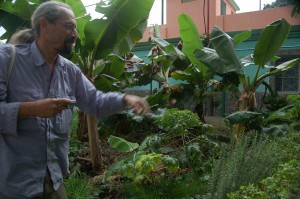
John Valenzuela.
Or if he doesn’t, Brock Dolman of the Occidental Arts and Ecology Center does. And so does my dear friend Penny Livingstone-Stark of the Regenerative Design Institute.

Penny Livingston-Stark in her palm leaf hat!
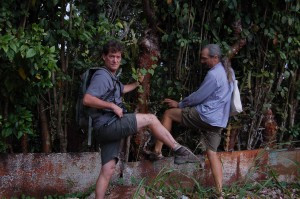
Brock Dolman and John Valenzuela show a little leg!
We visited three small gardens in one of the suburbs of Havana. I admired what Blanca had done in a small space while caring for a son with developmental problems.
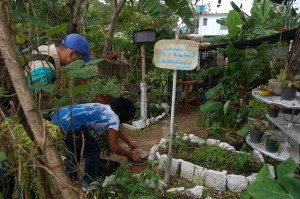
Bianca’s sistema.

Bianca’s little pond.
Another ‘sistema’, called, “My Dream” in Spanish, combined a lush, tropical food forest with raised beds. And finally we went to the home of the Sanchez family, who have turned their yard into a permaculture teaching site.

Banana trees and recycled hanging planters.
In the afternoon, we visited an agroponico, one of the urban farms where much of Cuba’s produce is grown. In the nineties, they were producing something like 70% of their food in and around their cities. But, as one of our guides admitted, they weren’t eating that much. Now, alas, they are back to importing something like 60%, but the urban farms remain.
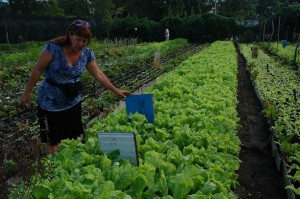
Beds of lettuce at the agroponico.
And then we were on to the convergence, five more days of presentations, discussions, long talks in long lines waiting for food, interludes at the beach or the pool, and at night—dancing! My high point of the trip: Bianca told me I was a good dancer, and one of the Cuban men said I danced like a Cuban girl!
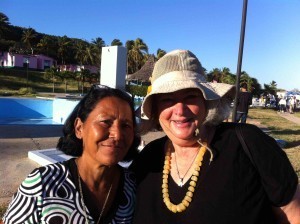
Bianca and me!
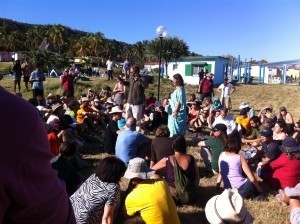
At the convergence: Robin Clayfield from Crystal Waters in Australia looking beautiful in blue!
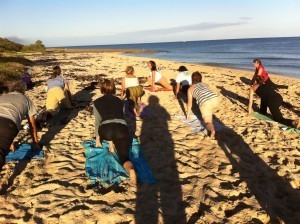
Yoga on the beach at the convergence.
Pandora Thomas and I presented a session together on social permaculture and building diversity in the movement, which was well-received.
I also led a spiral dance, and immediately afterwards faced a line of Cuban women asking me for advice on how to energetically cleanse themselves and how to ground before sleeping. One thing I loved in Cuba is that Santeria is accepted there as a religion—with more followers than Catholicism. There’s a respect for spiritual and energetic forces that all the years of Communism hasn’t dented.
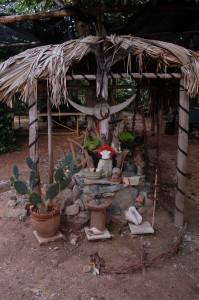
Santeria altar at the agroponico.
Then on to more tours. Matanzas, where a permaculture food forest is planted to protect amazing, crystalline underground caves! Sancti Spiritus, where Edith, one of the women I’d danced with, has turned a flower farm into a permaculture farm with the first earthen building in Cuba. We saw another site where they are building a model house/classroom out of recycled materials, and a permaculture car wash.
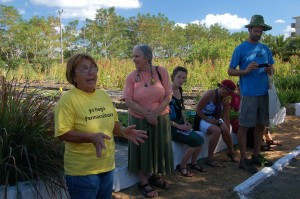
Edith at the flower farm converted to a permaculture center.

Mandala garden at Edith’s permaculture center.
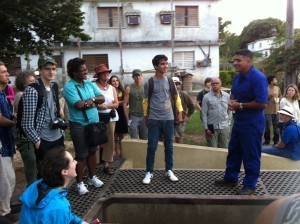
At the permaculture car wash, water is cleaned and recycled.
On our final day, we were taken high up into the tropical rainforest for a tour of a preserve that focuses on medicinal plants, and a lively herb walk. At the end, a few of us shared a quiet, stolen moment in a cave where long ago slaves had hidded to celebrate their ceremonies. We took a moment to honor their spirits, then hurried back along a beautiful path by the stream to get back to our busses.
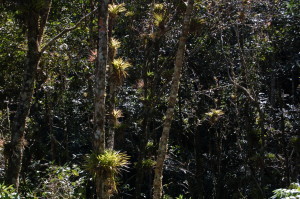
Bromeliads in the rainforest–anti-inflammatory, and also burn fat! Gotta get some!

Bromeliads and orchids!
I’m going to try to find more time to write up some of my thoughts from the conference. Overall, I’m incredibly grateful for the opportunity to meet with so many amazing people from around the world, and to see the wonderful work Cuba has done with permaculture and with all the ways it takes care of its people.

Non-carbon transport!
December 20, 2013
On Not Lighting a Solstice Bonfire
Winter Solstice, the longest night and shortest day of the year. The time of the year when darkness reigns and light seems a weak challenger. When the sun appears to stand still, and time stops. A time for letting go, for cleansing and release.
For decades now, the Reclaiming community of Pagans here in San Francisco has celebrated the Solstice at the beach, with a plunge into the ocean and a dance around the bonfire. The shock of cold, the trail of gold on the water, the exhilaration, the wild wind all carry away the last scraps of meanness and whining and disappointment left from the year. And the bonfire with its leaping flames offers warmth and light and community.
A simple ritual, its power carried by the elements themselves. It doesn’t depend on profound thinking, or poetic trance, or eloquent words, which you can’t hear anyway at the beach. Just the ocean, the fire, and the community.
But this year we won’t have a fire. Some years ago, the Golden Gate National Recreation Area banned fires on the beach. There were a number of reasons for this—trouble with litter and fires left untended and rowdy drunks, none of which applied to us. But there were also other issues, some of them environmental. After a big public outcry, they designated a small area at the north end of the beach, a good couple of miles from our more sheltered site, and the Burning Man artists created some special fire pits for it. But that area is crowded, wide open to public view, and not so beautiful and sheltered as the area where we traditionally hold our ritual. So for many years we simply ignored the ban.
Until this Summer Solstice, when we arrived to find the street lined with cop cars and the beach swarming with rangers armed with fire extinguishers. There had long been a plan in place, if the fire was threatened, to defend it with civil disobedience. But we’d had in mind a dignified blockade, leading perhaps to arrest where we could fight the matter in court as an issue of religious freedom. We hadn’t pictured the sacred fire extinguished with chemicals, and the firemakers served with something more like a parking ticket. In any case, after a discussion and a rough consensus, the group decided simply to forego the fire.
In retrospect, we should have gone to the GGNRA the next day and filed a protest, and begun our discussion then. But being busy people with a lot going on in already crowded lives, and having six months before our next beach ritual, we pondered, and grumbled, and muttered, and it wasn’t until the fall that we got organized and held a meeting, and not until this last week that we actually met with the GGNRA.
And the result was—mixed. On the positive side, we were assured that the GGNRA actually does respect our religious rights and is willing to work with us. But the issue involving the fire is out of the hands of our local office. For the beach is part of the snowy plover protection zone, one of only two places where they nest, and their protection is a matter of federal law.
Which leaves us in the position of asking for an exemption to an environmental law we actually support. Civil disobedience did not seem like the appropriate move, here. And so the discussion will go on—after Solstice, to determine what we do next summer, and next winter, and the summers and winters beyond.
And the issue has thrown me smack up against something I realize I have been trying to avoid, a deep and abiding sadness. I think everyone who loves the earth must be feeling it, that sense of things slipping away, pulled by the tide out of our grasp and gone—places of great beauty, species of remarkable birds, rain patterns we can count on, the confidence that our children’s children will inherit a world in which they can thrive. When we attune ourselves to what nature is saying, she’s shrieking in our ears that it is all spiraling out of control, too fast now to be easily stopped. And all the big systems, the governments and international agencies that are supposed to kick in and shift our direction are themselves all spiraling out of control, like tops wobbling in a wild gyre, crashing hardest on those least able to construct bulwarks of money and power.
I’m an optimist by nature, and an activist by choice. As long as I can still balance on creaky knees and draw a breath into wheezy lungs, I’ll keep on fighting the destruction and working for regeneration.
But on this Solstice when time stops, I have to stop, and draw a breath of the sea air, and face the possibility that we might lose. All our efforts might not be enough. Decisions made far away from us in inaccessible stratas of power steal away our future, and maybe we won’t be able to stop them.
It is everyone’s birthright, to plunge into the clean waves, to dance around a fire.
But the waves aren’t clean. By next summer, or next winter, if not already, they may carry to our shores the radioactive poisons of Fukushima. And the fire is banned.
Laws are blunt instruments, and I don’t for a moment believe that our bonfire on the beach would actually endanger a single snowy plover’s egg. (For one thing, they don’t nest in the winter!) But in this time of great extinction, I’ve got to throw my weight behind every effort at preservation, no matter how clumsy.
Yet I need this year’s cleansing. I need the great elemental forces to wash through me and carry away some of this grief and renew my faith in life’s resilience.
So tonight I embrace the cold. Call it in—cold is what we need, to cool the overheated earth, to bring back the rains. I offer up the fire, to the snowy plover, to all the endangered species, to everything and everyone whose simple birthrights are stolen.
Let this be the Solstice magic. Tides turn. Miracles happen.
Out of darkness, light is born.


